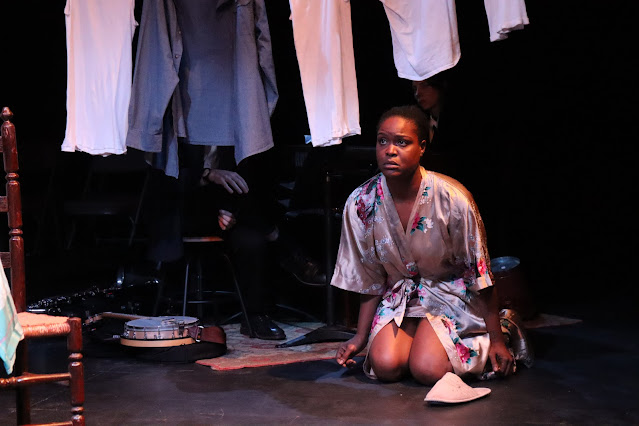galatea 2.0
Written by Sophie Dushko
Directed by C. C. Kellogg
24 Marcy Avenue, Brooklyn, NYC
July 6-23, 2023
 |
| Vincent Santvoord and Izabel Mar. Courtesy of Alton PR |
The coin toss at the outset of
galatea 2.0 blurs the lines between real and fictional worlds in a way that both is of a piece with the rest of the play and gains retrospective symbolic power by its end. The coin toss determines which of two actors will play human being Eliza and which a love doll with the product name Galatea 2.0 (unless you're seeing it on a Saturday night, when the actors swap the roles assigned by the afternoon show's coin toss). The suggestion of female interchangeability has deep resonance for a play interested in how men shape women–and women shape themselves–as vessels for men's desires, egos, and needs. From playwright and performer
Sophie Dushko and directed by facilitating artistic director of Invulnerable Nothings C. C. Kellogg,
galatea 2.0 is making its compelling world premiere as the first multi-week theatrical run of the new Brooklyn Art Haus in Williamsburg–a new perspective for a new venue on a story simultaneously of the moment and literally ancient.
 |
| Izabel Mar. Courtesy of Alton PR |
In Greek mythology, Pygmalion disdains actual women but falls in love with a female statue that he carves. The statue is brought to life by Aphrodite, and Pygmalion and his creation marry (the name Galatea comes to be associated with the statue through Jean-Jacques Rousseau's 18th-century play
Pygmalion). In Dushko's play, while one female character directly bears the name Galatea–in addition to a second name suggesting a kind of doubling with another character–its connotations encompass the others as well. Eliza (a terrific Violet Savage, per the coin toss on the day we attended) is a mostly online sex worker, but we are introduced to her on a day when she has agreed to meet a client in person to engage in paid role play. That client is Henry (Vincent Santvoord), a lonely worker in the tech industry whose problems include that he can only get off with a realistic sex doll and that his doll (Izabel Mar, per the coin flip), a custom model sculpted, as it were, to his own preferences, has developed some inexplicable problems. Eliza, thus, will stand in for the doll–notably, in a BDSM scenario that involves restraints and a ball gag. Henry and Eliza's awkward conversation afterwards might lead one to think that the play is moving in a certain direction, but then there is Mrs. Pat (Meg MacCary), an historical figure who made her acting debut in 1886 and for whom George Bernard Shaw created the role of a different Eliza in a different
Pygmalion. Mrs. Pat is the object of the affections–and sometimes ire–of theater-maker Joey (Vincent Santvoord again). She addresses the audience rather than interacting with Eliza and Galatea–at first. And that is before Pygmalion (Vincent Santvoord, once more) too enters the heady mix.
 |
| Meg MacCary. Courtesy of Alton PR |
As all of these pleasurably dense goings-on guide Eliza towards an altered focus on her 'self,' they frame an array of interpenetrating issues including objectification, performance of/as the self, conceptions of (male) artistry, and the reduction of the female body to fragmented simulacra. Seeing how Joey can act towards Mrs. Pat, for instance, and then finding out more about who he is prompts us to consider how far we excuse him for being–as Mrs. Pat characterizes him–a difficult (male) genius, a reaction that remains common for behavior far worse than his. Additionally, that Santvoord plays all the male characters invites us to perceive a sameness among them (a similar strategy and message to Alex Garland's 2022 film
Men) that is yet distinct from the implied interchangeability among the women. To take another example, Galatea remains onstage after Henry brings her out, both an object and a source of the gaze (in her case, seemingly unfixed but perceiving nonetheless–a kind of implied return of the looking of both characters and spectators). In a nice detail, at one point each of the others poses her in turn, her body a conduit for expressing their views of and around it. At another point, in a magnificently arresting monologue performance by Mar (rivaled, perhaps, by Santvoord when his brotastic Pygmalion attempts some public self-reflection), Galatea, in maybe the play's most concentrated use of quotation (MacCary's rendition of a Dolly Parton song counts as another instance, another layer of shaping and refashioning), ventriloquizes voices ranging from Judy Garland to Yoko Ono to Edie Sedgwick to Anna Nicole Smith. While the words are not her own, one can also view their appropriation and remixing as a source of power–appropriately enough for a play that does such things itself. Throughout, Jacqueline Scaletta's lighting design lends subtle enhancement to these thematic and character moments.
While the idea of the image that does not point to an original–like Galatea 2.0 herself, like Eliza's online presence, and like the sex
symbol–is solidly postmodern, the larger questions that it points to can be traced back much further. Eliza's description of conceiving of herself as discrete fragments, for example (which she connects to a bodily estrangement also experienced by Henry), might put one in mind of the metaphoric dismemberment enacted in early modern love sonnets through their focus on body parts. The similarities between acting and sex work pointed out by Mrs. Pat bear a similarly lengthy history, as Kirsten Pullen's study
Actresses and Whores (2005) attests. Challenging, funny, and, finally, cathartic,
galatea 2.0 offers a pedestal-smashing intervention for our isolating age.
-John R. Ziegler and Leah Richards






Comments
Post a Comment